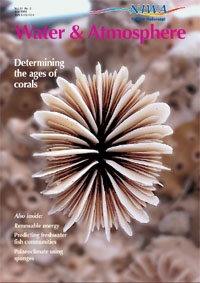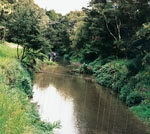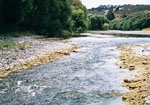PDF of this article (9 MB)

Jody Richardson Ian Jowett
Can you tell which fish communities inhabit the streams in the photographs? Read on – and then try our test!





The waterways pictured left represent a range of typical New Zealand streams. Can we predict the resident fish community from just a photograph? The results of our recent analysis of data from the New Zealand freshwater fish database suggest that we can, but first we need more information, particularly about the stream’s location.
What is a fish community?
A fish community is an assemblage of fish species that inhabit a particular area of a stream or river. Based on 40 years of accumulated field sampling, we now know that certain fish species commonly occur together whereas others don’t. This is usually related to their preferred habitat and, for diadromous species (that spend a part of their life-cycle at sea), their ability to penetrate inland. For example, open-bed, fast-water species such as torrentfish and bluegill bully are often found together, but are practically never found with pool-dwelling bush species such as adult banded kokopu. Thus, we would expect a torrentfish community to inhabit quite different types of waterways from a banded kokopu community.
But why bother with fish communities?
Water management decisions often focus on single valuable or threatened fish species, but usually rivers contain a whole community of fish. Knowing what species occur together and in what types of waterways can help managers predict the effects of flow and land management options on the whole community. This approach not only protects individual species and biodiversity, but also helps identify appropriate restoration and conservation strategies for a particular waterway.
Defining fish communities
We used an analysis of the New Zealand Freshwater Fish Database (NZFFD) – plus experience – to describe common fish communities and to determine their predict-ability. The NZFFD contains information on freshwater fish from sites throughout New Zealand. We selected quantitative data (collected using electric fishing) because we thought the most abundant fish species – and not those that just occur by chance – should define a community. Our 1130 sites were therefore mainly small and medium-sized wadeable waterways. We excluded fish communities from deep-water and/or still-water habitats unsuited for electric fishing.
We combined the fish data with site information such as location, stream width and catchment land use. The first stage of the analysis was to use a computer program to classify sites by their fish assemblages into biologically sensible groups. We then examined the results to see whether the communities matched our experience and intuitive definitions.
Most of the groups identified by computer analysis were immediately familiar to us. For example, upland and lowland fish communities were clearly separated. We defined 12 fish communities, though many species occurred in several of these.
Environmental information for predicting communities
After each site had been assigned to a fish community, we then used the differences in the site locations and physical characteristics to develop our models for predicting fish communities.
Geographic location was the over-riding factor influencing fish communities. The distribution of many of the communities depended on whether the fish were diadromous or not, and the ability of the diadromous species to penetrate inland. Altitude showed the most difference between communities, closely followed by distance inland.
Habitat was a less obvious factor but was important for some fish species. For example, banded kokopu were typically found in small streams (average width 1.6 m), whereas torrentfish occurred in wide streams (average width 10.5 m).
Overall, our best predictive model used a combination of five location variables (altitude, distance inland, northing, island, easting), three catchment vegetation variables (farming, native, exotic forest), and stream width.
Some communities were easier to identify and predict than others. For example, more than half of the koaro, inanga, Crans bully, upland bully, and rainbow trout communities could be successfully predicted from the environmental variables, whereas less than a fifth of longfin eel and shortjaw kokopu communities could. The lowland communities characterised by redfin bully, torrentfish and shortfin eel were also difficult to classify consistently.
The communities
We generally named the communities after their dominant fish species.
Banded kokopu, shortjaw kokopu, redfin bully
The characteristic species of these three communities were found living together, as well as with longfin eel and koaro. The preferred habitat was small bush-covered streams. All were associated with native forest (more than 60% of the catchment) and a low percentage of farming development (less than 22% of the catchment).
Banded kokopu community streams were the smallest (1.6 m wide) and had the highest percentage of pool habitat. Location was distinctly coastal, but throughout the Bay of Plenty, Coromandel, Waikato and Auckland regions. South Island locations were on the west coast, in the Catlins, Otago and Banks peninsulas and Marlborough Sounds. Shortjaw kokopu communities were mainly found in rivers draining to the south Taranaki Bight, Golden Bay and the Marlborough Sounds. Redfin bully communities were widely scattered but were very rare on the east coast of either island.
Inanga, shortfin eel, torrentfish
These three communities also had a similar species assemblage, including relatively high densities of the diadromous bully species. They were usually found at lower altitudes than the previous three communities. Inanga communities were confined to very low altitudes, with none found farther than 50 km inland. They were rare in northern New Zealand.
Sites with shortfin eel communities occurred in farmed catchments rather than native bush and were associated with mud streambeds. Most occurred in the North Island, perhaps reflecting this species’ preference for relatively warm water.
Torrentfish inhabit riffles in open riverbeds. Sites with this community had the highest average stream width of all the groups, and a low percentage of pool habitat. The torrentfish community had the highest average density of bluegill bullies, which also prefer a riffle habitat. Torrentfish communities occurred equally in the North and South Island, but generally at low elevations and not very far inland.
Crans bully community
The non-diadromous Crans bully occurs only in the North Island, but not in the Bay of Plenty or East Cape where its extinction is thought to be due to the Taupo eruptions. Crans bully communities contained mainly Crans bully and eels, and occurred at lower average elevations than the other non-diadromous communities. However, the sites were well inland, particularly in the low-gradient Manawatu and Wanganui catchments. The communities occurred across all land uses and tended to inhabit wide streams with a high percentage of pools.
Upland bully community
Upland bullies do not occur north of Lake Taupo, in northwest Nelson, or on the west coast of the South Island south of the Hokitika River. Nevertheless, this group was second largest, occurring at moderate altitudes and distances inland. Some of the less common non-diadromous galaxiid species, including dwarf, alpine and Canterbury galaxias, were found in this community.
Koaro community
Koaro community streams had the highest average percentage of native forest (90%) and usually contained cascade habitat. They were often at high elevations. In the North Island, the koaro communities occurred south of a line between East Cape and Taranaki, but not on the east coast south of Hawkes Bay. In the South Island, koaro communities were mainly confined to the west coast, Southland and Otago.
Brown and rainbow trout communities
Trout communities occurred at high elevations and were generally farther inland than any of the other groups. The brown trout community was the largest group identified and was widespread except in the northern part of the North Island, where warm winters inhibit successful egg development.
Rainbow trout communities were restricted to the central North Island and a few sites associated with large inland lakes in central Otago. A previous study found that brown and rainbow trout communities tended to inhabit places with different kinds of water flow. In particular, rainbow trout communities were associated with lake- and spring-fed rivers with stable flows, such as those in the central North Island. The low percentage of farming land use in the site catchments probably reflects the location of most lake catchments in unfarmed areas.
Longfin eel community
Longfin eels are ubiquitous and were usually the most abundant or second most abundant species in any community. Their climbing ability allows them to gain access to the headwaters of most New Zealand rivers and they are absent only from some rivers in the central North Island. Sites classified as containing longfin eel communities were well inland at high altitudes, beyond the reach of other diadromous species. It was very difficult to predict these locations, because we had no information on the presence of waterfalls or rapids that might be a barrier to the passage of other fish species.
Can you predict the fish community?
Now that you have been given some information about the fish communities and their environmental characteristics, read the photo captions for some details about the location of the streams shown. Try to guess which community it contains based just on this information and the picture. We think you will find it can be done! When you have finished check the answers.
Teachers: this article can be used for NCEA Achievement Standards in Biology (1.2, 2.2, 2.5, 2.6, 3.4). See other curriculum connections at www.niwa.co.nz/pubs/wa/resources
Jody Richardson and Ian Jowett are based at NIWA in Hamilton.
